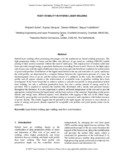JavaScript is disabled for your browser. Some features of this site may not work without it.
| dc.contributor.author | Suder, Wojciech | |
| dc.contributor.author | Ganguly, Supriyo | |
| dc.contributor.author | Williams, Stewart W. | |
| dc.contributor.author | Yudodibroto, Bagus | |
| dc.date.accessioned | 2017-06-09T14:49:17Z | |
| dc.date.available | 2017-06-09T14:49:17Z | |
| dc.date.issued | 2017-05 | |
| dc.identifier.citation | Wojciech Suder, Supriyo Ganguly, Stewart Williams and Bagus Yudodibroto. Root stability in hybrid laser welding. Journal of Laser Applications, Volume 29, Issue 2, article number 022410 (2017) | en_UK |
| dc.identifier.issn | 1042-346X | |
| dc.identifier.uri | http://dx.doi.org/10.2351/1.4983161 | |
| dc.identifier.uri | https://dspace.lib.cranfield.ac.uk/handle/1826/11997 | |
| dc.description.abstract | Hybrid laser welding offers promising advantages over the traditional arc-based welding processes. The high penetration ability of lasers and the filler wire delivery of gas metal arc welding (GMAW) enable joining of thick section materials without the need of multi-pass. The output power of modern solid state lasers provides enough energy to penetrate thicknesses exceeding 20 mm in steel. However, the high aspect ratio fusion zone with the rapid solidification does not always provide beneficial conditions for achievement of good weld profiles. Distribution of the liquid metal between the top and root sides of a joint, and hence the weld profile, are determined by a complex balance between the vaporization pressure of a laser, the electromagnetic force of an arc and the surface tension of a meltpool. In this work, the stability of root profile and all aspects related to the achievement of acceptable roots in pipeline welding have been investigated. It has been found that in order to achieve a smooth root profile in deep penetration hybrid laser welding, not only a sufficient penetration force, but also a certain amount of energy need to be provided. This is required to maintain the keyhole fully developed with a steady state pressure balance throughout the thickness. It is also important to achieve sufficient temperature in the root and to provide appropriate wetting between the liquid metal and the back surface of the material. Depending on the power density and energy used, different regimes were identified with sagging of the root in the initial stage, followed by good quality root profiles and then ending on excessive melt expulsion with further increase of power density. The results suggest that if operated in the right regime, the process is very tolerant, in terms of energy and power density required for acceptable root profiles and good quality joints can be achieved. | en_UK |
| dc.language.iso | en | en_UK |
| dc.publisher | Laser Institute of America | en_UK |
| dc.rights | ©2017. Laser Institute of America. Please refer to any applicable publisher terms of use. | |
| dc.subject | Laser hybrid welding | en_UK |
| dc.subject | pipe welding | en_UK |
| dc.subject | melt flow | en_UK |
| dc.subject | root formation | en_UK |
| dc.title | Root stability in hybrid laser welding | en_UK |
| dc.type | Article | en_UK |
Files in this item
This item appears in the following Collection(s)
-
Staff publications (SATM) [4471]
